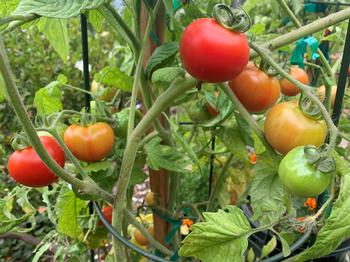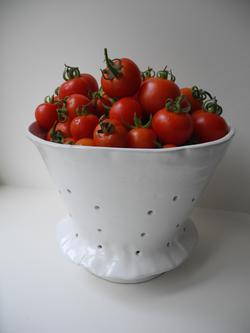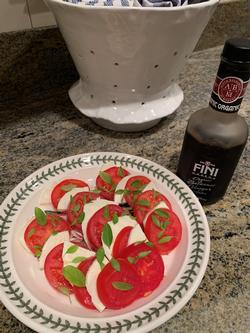Growing tomatoes from seed to salad
-
Anne-Marie Walker
-
 Tomatoes are a naturally vining plant. Stakes give support and cages minimize contact with soil and allow sun to ripen fruit. Photo: David S. Walker
Tomatoes are a naturally vining plant. Stakes give support and cages minimize contact with soil and allow sun to ripen fruit. Photo: David S. Walker
In 2020, scientists announced the discovery of the missing link between modern tomatoes and their wild ancestors. Using genome sequencing, a wild species in Ecuador and Peru was confirmed as long as 80,000 years ago. About 7,000 years ago, wild tomato plants with fruit the size of blueberries were bred to produce cherry-sized tomatoes. Mesoamerican farmers eventually bred these into our modern tomatoes, which grow best where temperatures are no higher than 90 degrees and no cooler than 55 degrees. It’s no wonder so many pathogens plague this tropical plant. The plentiful harvest is displayed in a hand thrown colander from Peru, home of wild ancestor tomatoes. Photo: Anne-Marie Walker
The plentiful harvest is displayed in a hand thrown colander from Peru, home of wild ancestor tomatoes. Photo: Anne-Marie Walker
By mid to late summer, gardeners invariably ask each other “How are your tomatoes?” So, we worry if our tomatoes are getting enough sun, enough water, or are they getting blight? Are they splitting or besieged by pests? Ultimately of most concern, “Are they sweet enough?” The tomato seed you select to plant is your first big decision. I like to pick a mix of heirloom and hybrid seeds. Research points to higher sugar content in heirlooms and disease resistance is better in hybrids. During domestication, favorable taste genes got lost while crop yield, disease resistance and transportation friendly traits got emphasized. Ongoing research at UC Davis Tomato Genetic Resource Center focuses on retaining flavor while advancing disease resistance and crop yield. At the University of Florida, research defines ideal flavor as a complex blend of sweet and sour. For gardeners, the important takeaway is high sugar and high acid content in tomatoes is greatly influenced by sunlight reaching the fruit, plant nutrition and healthy soil. Grow tests demonstrate healthy soil translates to sweet taste that can’t be achieved with fertilizer supplements.Here is how to grow tasty tomatoes in your garden from seed to salad. Mail order tomato seeds and start the seeds indoors 6 to 8 weeks before the last spring frost in a sunny south facing window. Sow seed ¼ inch deep in potting soil keeping it evenly moist and warm. Choose the sunniest spot in your garden and build good soil with lots of organic matter and compost. Transplant the seedlings when they are about 6 to 8 inches tall making sure to first acclimatize them to increasing periods of light and varying temperatures. Dig a hole and put a fish head in the bottom. As it decomposes, it releases nitrogen, phosphorus and calcium to the roots. Lacking a fish head, you can purchase bone meal, a soil amendment that adds the same minerals. Pinch off lower leaves and plant deeply leaving just two sets of leaves above soil level. This promotes new root growth. Because tomatoes are naturally vining plants, as you fill in the hole with more potting soil, insert a support stake and cage to simplify care and harvest. Use good watering techniques that avoid dry-wet cycles, avoid splashing water on the leaves and mulch with more compost. Once a week watering usually suffices and once fruit sets, feed with fish emulsion fertilizer once every 4 to 6 weeks. On average, tomato plants bear mature fruit 2-3 months from transplant. If you planted mid-May, you could harvest your first tomato around the end of July. Read your seed envelopes for exact timing. Let fruit ripen on the vine and harvest at full color. Store at room temperature as refrigeration causes flavor loss. Save seed for next year’s garden but only from heirlooms as hybrids, from two parents, do not produce to type. Enjoy a simple but glorious salad of sliced tomatoes, fresh mozzarella & homegrown lemon basil. Drizzle with balsalmic vinegar. Photo: David S. Walker
Enjoy a simple but glorious salad of sliced tomatoes, fresh mozzarella & homegrown lemon basil. Drizzle with balsalmic vinegar. Photo: David S. WalkerTo learn more, go to marinmg.org and click on the link to Edibles, then Tomatoes to get a more complete how-to guide for starting tomatoes from seed.



